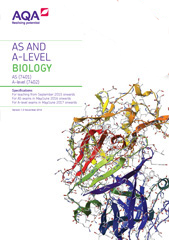3.5 Energy transfers in and between organisms (A-level only)
Life depends on continuous transfers of energy.
In photosynthesis, light is absorbed by chlorophyll and this is linked to the production of ATP.
In respiration, various substances are used as respiratory substrates. The hydrolysis of these respiratory substrates is linked to the production of ATP.
In both respiration and photosynthesis, ATP production occurs when protons diffuse down an electrochemical gradient through molecules of the enzyme ATP synthase, embedded in the membranes of cellular organelles.
The process of photosynthesis is common in all photoautotrophic organisms and the process of respiration is common in all organisms, providing indirect evidence for evolution.
In communities, the biological molecules produced by photosynthesis are consumed by other organisms, including animals, bacteria and fungi. Some of these are used as respiratory substrates by these consumers.
Photosynthesis and respiration are not 100% efficient. The transfer of biomass and its stored chemical energy in a community from one organism to a consumer is also not 100% efficient.
Photosynthesis (A-level only)
Content |
Opportunities for skills development |
|---|---|
The light-dependent reaction in such detail as to show that:
The light-independent reaction uses reduced NADP from the light-dependent reaction to form a simple sugar. The hydrolysis of ATP, also from the light-dependent reaction, provides the additional energy for this reaction. The light-independent reaction in such detail as to show that:
Students should be able to:
|
AT a Students could devise and carry out experiments to investigate the effect of named environmental variables on the rate of photosynthesis using aquatic plants, algae or immobilised algal beads. |
Required practical 7: Use of chromatography to investigate the pigments isolated from leaves of different plants, eg, leaves from shade-tolerant and shade-intolerant plants or leaves of different colours. Required practical 8: Investigation into the effect of a named factor on the rate of dehydrogenase activity in extracts of chloroplasts. |
AT g and b |
Respiration (A-level only)
Content |
Opportunities for skills development |
|---|---|
Respiration produces ATP. Glycolysis is the first stage of anaerobic and aerobic respiration. It occurs in the cytoplasm and is an anaerobic process. Glycolysis involves the following stages:
If respiration is only anaerobic, pyruvate can be converted to ethanol or lactate using reduced NAD. The oxidised NAD produced in this way can be used in further glycolysis. If respiration is aerobic, pyruvate from glycolysis enters the mitochondrial matrix by active transport. Aerobic respiration in such detail as to show that:
|
AT b Students could use a redox indicator to investigate dehydrogenase activity. |
Required practical 9: Investigation into the effect of a named variable on the rate of respiration of cultures of single-celled organisms. |
AT b and i |
Energy and ecosystems (A-level only)
Content |
Opportunities for skills development |
|---|---|
In any ecosystem, plants synthesise organic compounds from atmospheric, or aquatic, carbon dioxide. Most of the sugars synthesised by plants are used by the plant as respiratory substrates. The rest are used to make other groups of biological molecules. These biological molecules form the biomass of the plants. Biomass can be measured in terms of mass of carbon or dry mass of tissue per given area. The chemical energy store in dry biomass can be estimated using calorimetry. Gross primary production ( ) is the chemical energy store in plant biomass, in a given area or volume. Net primary production ( ) is the chemical energy store in plant biomass after respiratory losses to the environment have been taken into account, ie where represents gross production and represents respiratory losses to the environment. This net primary production is available for plant growth and reproduction. It is also available to other trophic levels in the ecosystem, such as herbivores and decomposers. The net production of consumers ( ), such as animals, can be calculated as:
where represents the chemical energy store in ingested food, represents the chemical energy lost to the environment in faeces and urine and represents the respiratory losses to the environment. Primary and secondary productivity is the rate of primary or secondary production, respectively. It is measured as biomass in a given area in a given time eg kJ ha–1 year–1. Students should be able to appreciate the ways in which production is affected by farming practices designed to increase the efficiency of energy transfer by:
|
MS 0.1 Students could be given data from which to calculate gross primary production and to derive the appropriate units. AT a Students could carry out investigations to find the dry mass of plant samples or the energy released by samples of plant biomass. MS 2.4 Students could be given data from which to calculate:
MS 0.3 Students could be given data from which to calculate percentage yields. |
Nutrient cycles (A-level only)
Content |
Opportunities for skills development |
|---|---|
Nutrients are recycled within natural ecosystems, exemplified by the nitrogen cycle and the phosphorus cycle. Microorganisms play a vital role in recycling chemical elements such as phosphorus and nitrogen.
(The names of individual species of bacteria are not required). The use of natural and artificial fertilisers to replace the nitrates and phosphates lost by harvesting plants and removing livestock. The environmental issues arising from the use of fertilisers including leaching and eutrophication. |
PS 1.1 Students could devise investigations into the effect of named minerals on plant growth. |
